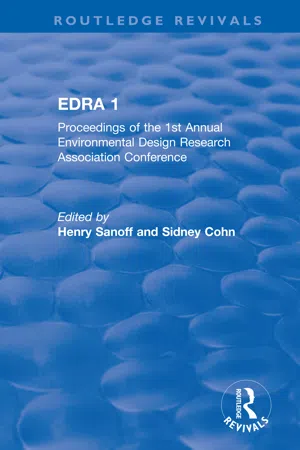There are many problems associated with the design and planning of public housing. Quite often, so much stress is placed on economic feasibility, durability and ease of maintenance that public housing developments seem to lack visual appeal. Peter Rossi, in a study entitled Why Families Move, indicates that some very basic spatial and utilitarian needs rank before the social and physical environment as impetus for complaint.1
To be sure, the aesthetic attractiveness of a dwelling complex does not rank as the primary problem with most low-income families. However, when other more functional criteria have been satisfied, the appearance of the immediate physical environment does affect preferential choices.
Many of the problems of visual appearance seem inherent to mass public housing developments. Catherine Wurster states:
Public housing projects tend to bery largely and highly standardized in their design. Visually they may be no more monotonous than a typical suburban tract, but their density makes them seem much more institutional2
Architects and planners often strive for solutions to such problems without any knowledge of the values of the occupants. Practically speaking, designers often lack any direct contact with the future occupants of such developments and, consequently must rely on planning procedures not appropriate for the social groups involved. In actuality most low-income persons do aspire to look and live like the middle classes.3 If this is true, the problem of designing more satisfying visual environments becomes simpler. However, there is little evidence from research findings that visual satisfaction can be measured or predicted. This lack of understanding would apply to any development which affected the visual environment, regardless of the income or social group.
There has been speculation that the visual image may be subject to measures of satisfaction based on inherent psychological and perceptual phenomena. Rapoport, Kanter, Miller and Vigier have all indicated that satisfaction with the perceived environment may depend upon the amount and organization of the information presented the observer.4 Fiske and Maddi assert that it can be demonstrated in more basic situations that “there is a level of activation which is necessary for maximally effective performance’5
The Problem
The purpose of this investigation is to survey the preferences of people for various public housing environments and to isolate some of the aesthetic criteria which are instrumental in the choice of a satisfying residential environment. The housing environment in this study refers to the general exterior appearance of the public housing dwelling group, as it may appear on its particular site. Criteria under investigation are limited to the qualities of visual appearance which may influence the aesthetic satisfaction of a prospective resident.
The scope of the study is limited to include only multi-family dwelling structures, one to three floors in height with emphasis on the relationship of the individual dwelling to the site and to surrounding dwellings. The housing environments are selected to represent a range of aesthetic types normally associated with public housing projects.
Research Design
The research design follows a single-cell model of investigation commonly used in exploratory surveys. The subjects are asked to select those residential environments which they would prefer if they were actually selecting a dwelling. Each of the situations are represented by photos of the unit and its site. (See Appendix A) Since the design of a successful instrument depends on the quality of the simulation, care was taken to provide an accurate and descriptive photographic representation of each housing group. Eighteen different situations were chosen to offer a variety of dwelling and site conditions. Each could be classified as a multi-family structure and none was over three floors in height. A typical dwelling-site relationship was represented for each housing environment.
The subjects, as the sample group, are treated as a control variable. The sample was chosen primarily on the basis of common age, educational training and social standards. The survey results which are reported were obtained from a sample of twenty-five fourth and fifth year students studying architecture, landscape architecture and product design. The judgments were obviously made on the basis of limited information. In each situation there may have been factors present in the everyday situation which would have affected judgments. However, this is a recognized possibility for each of the photographs. None of the observers had the opportunity of actually experiencing the dwellings.
The preference of the sample group is considered to be dependent on three independent evaluations of the housing environments. These are the degree of visual complexity, the perceived cost of the dwelling and the amount of privacy offered by the dwelling environment. The data collection device is designed to provide an indication of the respondent’s experience in housing types and living patterns. Because the sample group was limited to students of the School of Design, whose educational and social background was known, no other general questions were included. Each subject was asked to indicate his impression of the characteristics of an imagined good residential environment. This provided a basis for comparison with the characteristics of the preferred housing environments.
The remaining three resorts required categorical judgments of expensive/economical, private/public, and simple/complex. Each subject was presented a deck of eighteen cards which had been randomly identified by letters of the alphabet. Each card was a photo-simulate of a housing type. Four separate evaluations were required and each involved sorting the card deck. The forst required grouping according to preference, in five categories ranging from “like very much” to “disli...
